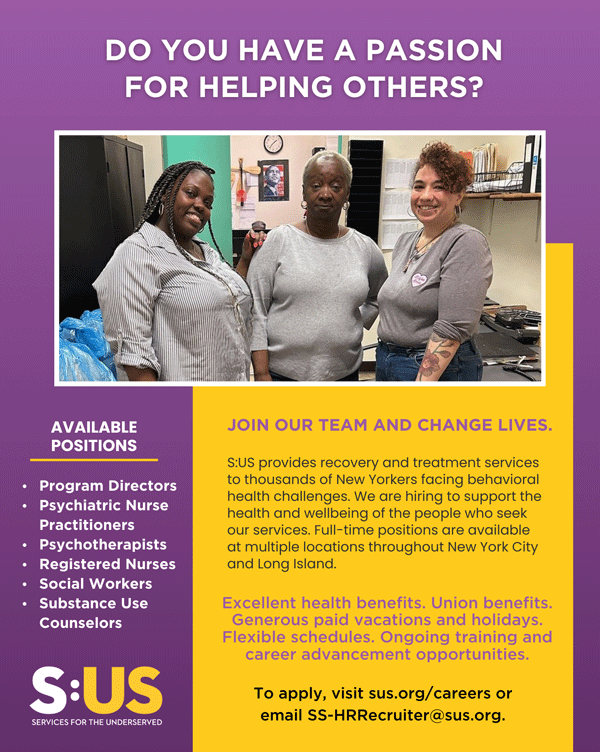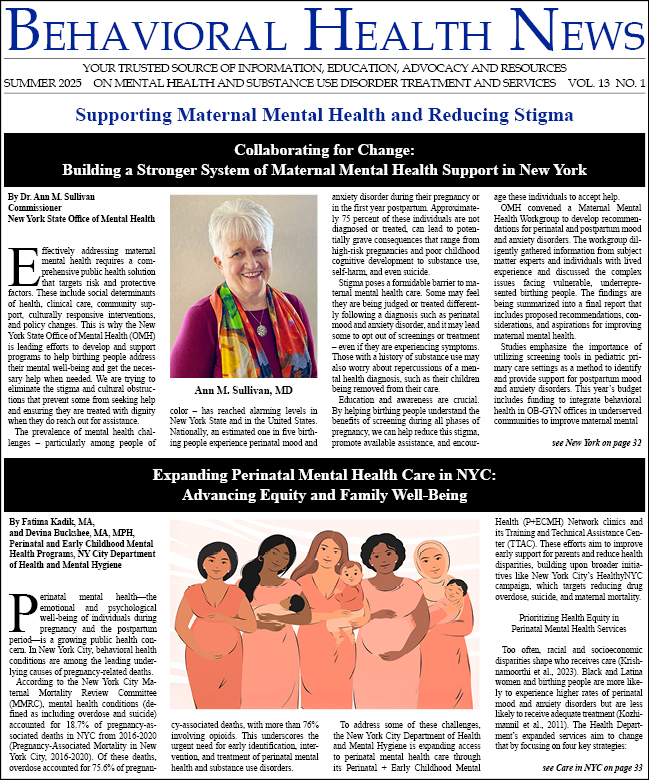Services for the UnderServed (S:US) is one of the premier and largest community-based social services agencies in New York State. Its mission is to “drive scalable solutions to transform the lives of people with disabilities, people in poverty, and people facing homelessness: solutions that contribute to righting societal imbalances.” S:US creates a compassionate environment through a combination of concrete social services in our shelters for adult families, single adults, and families with children. We prioritize offering essential social services that cater to the unique needs of those we serve. We understand that trauma can profoundly impact young children, youth, and families, affecting their physical and mental health, as well as their economic and housing situations. By embracing a trauma-informed approach, we strive to support and empower individuals and families on their journey toward healing and stability. iii

In this article, I will explore the effects of trauma on homeless individuals and families, discuss trauma-informed care as a healing approach, and examine the impact of homelessness on both those directly affected and society as a whole. Homelessness is an intractable social problem for which there are no easy solutions. Many factors contribute to the onset, duration, and type of homelessness amongst individuals of all ages. Homelessness, at its core, signifies the profound loss of not just a home but also community, stability, safety, and vital social connections. The demographic landscape of people experiencing homelessness reveals a nuanced and pressing reality in our society. This population is increasingly younger, with a notable rise in women with children, youth, and people of color facing these challenges. ii; v
S:US’ goal and vision is to eradicate chronic homelessness and keep New Yorkers healthy. Many advocates for the homeless argue that to effectively eliminate homelessness, we need to increase the availability of supportive housing, provide government-subsidized vouchers, and boost the supply of affordable permanent housing. Additionally, it is essential to offer wraparound services once participants transition from shelters to permanent housing to help prevent them from returning to the shelter system. The trauma associated with homelessness can be particularly severe for young children and families living in shelters. iv
Understanding Trauma-Informed Care (TIC) for young children and families in our shelters involves more than just addressing the trauma experienced by the people we serve. It is a framework that acknowledges the significant impact that trauma can have on an individual. This approach is currently being used in our shelters and various settings and is shifting the mindset from “What’s wrong with you” to What happened to you.” Part of the engagement process is recognizing that service providers must have a complete picture of a person’s life situation, both past and present, to promote effective care. i
Trauma-Informed Care (TIC) is not a specific treatment; rather, it is a comprehensive approach to delivering services that incorporates an understanding of trauma into practices, care, and policies. The goal of TIC is to create an environment that is safe, supportive, nurturing, and empowering for both the people served and staff. Understanding TIC as a healing approach in our shelters is crucial for effective service delivery and case management practices. TIC emphasizes the importance of providing a supportive environment that acknowledges and respects the impact of trauma on individuals. vii
There are six guiding principles of Trauma-Informed Care, which are essential for effective service delivery to the people we serve.
- Safety: Ensuring the physical and emotional safety of people served and staff by creating a secure environment. This space allows participants to explore and process traumatic memories without the fear of re-traumatization. For example, in our facilities, during the intake process and subsequent interventions, our social services staff meet with a person served in a private setting to conduct a family assessment. Before starting the assessment, the participant is reassured that they are in a safe space. They are informed that if they do not wish to share their past experiences, that is perfectly okay. As they become more familiar with the shelter system and begin their emotional healing, they are encouraged to open up, knowing they can talk about their past and present situations in a safe environment. v; vii
- Trustworthiness and Transparency: Staff build trust by communicating consistently and calmly. Establishing consistent boundaries is essential for fostering a trusting relationship. Trustworthiness and transparency are fundamental to our approach. Our staff is dedicated to applying these guiding principles when counseling people served. We communicate clearly and proactively to ensure that they understand the information shared with them. If clarification is needed, we reiterate key points to provide complete clarity. For example, one of the tasks assigned to a participant is to open a public assistance case. Our staff guides them through the process and provides counseling on how to create an account on the public assistance portal. vi
- Peer Support: Collaborating and connecting with others in both group and individual settings who have had similar experiences fosters a sense of belonging and validation. This feeling is essential to the healing process. For example, our Peer Specialist facilitates group activities centered on money management and budgeting. These sessions allow people served and staff to explore the concept of budgeting and its personal significance. Participants engage in meaningful discussions about their experiences, sharing valuable insights and strategies for effectively managing their finances and supporting their families, even in the face of various challenges. vii
- Collaboration and Mutuality: Communicating with a sense of “doing with” rather than “doing to” is essential. Staff and persons served collaborate to create Independent Living Plans and service plans that help equalize power dynamics, making the participant feel empowered in their healing journey. During the Independent Living Plan (ILP) sessions, the participant’s voice is recorded as they develop plans for transitioning from the shelter to permanent housing. The ILP focuses on the person served and is conducted in collaboration with them, fostering a sense of autonomy in their lives. vii
- Empowerment and Choice: This principle empowers trauma survivors by emphasizing their strengths, providing them with choices in decision-making, and encouraging their active participation in achieving goals. Trauma survivors may experience a sense of powerlessness. To address this, staff facilitate empowerment by incorporating the voices of the people they serve in the Independent Living Plan (ILP) and encouraging them to share their opinions on the activities they participate in. For example, in our shelters, we prioritize empowering people served to take an active role in crafting their own housing plans. They have the freedom to choose the borough they wish to live in or explore options outside of the five boroughs. Our approach to case management is rooted in a participant-driven model, which fosters collaboration and personal growth. This participant-driven strategy transforms the relationship between staff and the people we serve. Staff recognize that each person is a valuable participant who understands their own needs and aspirations. This collaborative spirit enhances their autonomy in making informed housing choices. In contrast, in a provider-driven model, individuals may be seen as problems to be solved, leading to a focus on compliance with treatment plans rather than fostering empowerment and support. By embracing a participant-driven approach, we create a supportive environment that encourages growth and self-determination. iv; v; vi
- Cultural Sensitivity and Gender Awareness: Individuals and families seeking shelter often come from marginalized communities and backgrounds. They frequently face discrimination, which can significantly affect their experiences of trauma and their responses to it. Service providers must be aware of these cultural factors and educated on how to address them to effectively support the healing process. Our shelters conduct group sessions focused on cultural awareness, where people served and staff engage in meaningful dialogue about their cultures. These discussions help participants understand how to adapt to their situations, reassuring them that they are not alone. The staff is present to provide guidance and support. iv; v; vii
The societal cost of homelessness is significant, as it impacts us all; homeless youth, children, and families are vital threads in the fabric of American culture. We must recognize and address this issue, for their well-being is intertwined with our collective strength and humanity. As dedicated service providers, S:US recognizes the vital importance of adopting Trauma-Informed Care as a transformative approach. This method allows us to deeply understand and effectively deliver therapeutic services, fostering a safe and nurturing environment for the people we serve. By embracing Trauma-Informed Care, we equip them with the skills and support they need to carry forward as they embark on their journey toward permanent housing. At S:US, we are united by a powerful vision: to eradicate chronic homelessness in our society and create a future where everyone has a place to call home. iv
Joseph Esheyigba, LMSW, MPA, SIFI, is Vice President of Homeless Services at Services for the UnderServed (S:US).
Footnotes
i. Bogle (2016-01-22) Trauma-informed Care: An Ecological Response (https://air.org/resource/journal-article/trauma-informed-care-ecological-response). American Institutes for Research. Retrieved 2019-10-13.
ii. Johnson, C & Marcus, L (2021) The Complex link between Homelessness and Mental Health.
iii. Popple, P.R. & Leighninger, L. (1996). Social Work, Social Welfare and American Society, (3rd ed). Boston, MA: Allyn & Bacon.
iv. Ranjbar, Noshene: Erb, Matt; Mohammad, Othman; Moreno, Francisco A (2020-01-01) Trauma Informed Care and Cultural Humility in the Mental Health Care of People from Minoritized Communities (https://pmc.ncbi.nlm.nih.gov/articles/PMC7011220/)
v. Resher, M.(2017) Facing the Facts. Trauma-Informed Practices in Homeless Intervention Services.
vi. Rose, S.M & Moore, V.L. (1995). Case Management. In R.L. Edwards (Ed-In-Chief), Encyclopedia of Social Work (19th Edition,pp.338). Washington DC: NASW Press.
vii. Swartz, N (2024) The 6 Core Principles of Trauma- Informed Care and their Role in Trauma Therapy.







